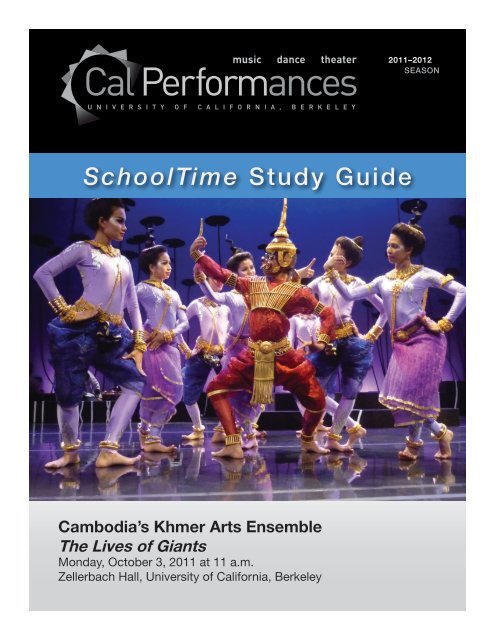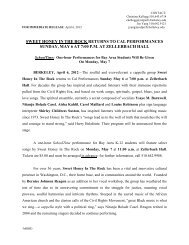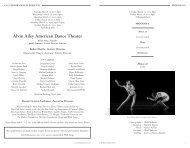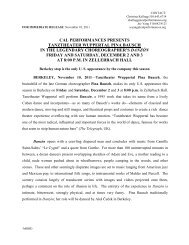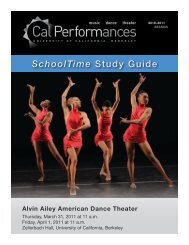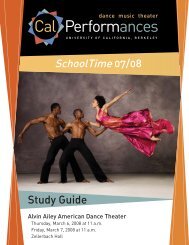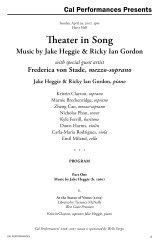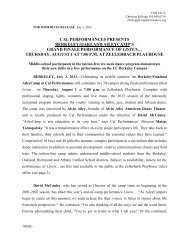Cambodia's Khmer Arts Ensemble - Cal Performances - University of ...
Cambodia's Khmer Arts Ensemble - Cal Performances - University of ...
Cambodia's Khmer Arts Ensemble - Cal Performances - University of ...
You also want an ePaper? Increase the reach of your titles
YUMPU automatically turns print PDFs into web optimized ePapers that Google loves.
Table <strong>of</strong> Contents1. Theater Etiquette 12. Student Resource Sheet 23. About the Performance and the Artists 44. About the Art Form 75. About Cambodia 116. Learning Activities & Resources 157. <strong>Cal</strong>ifornia State Standards 19About SchoolTime 19| SchoolTime Cambodia’s <strong>Khmer</strong> <strong>Arts</strong> <strong>Ensemble</strong>
1 Theater EtiquetteBe prepared and arrive early. Ideally you should arrive at the theater 30 to 45 minutesbefore the show. Allow for travel time and parking, and plan to be in your seats at least 15 minutesbefore the performance begins.Be aware and remain quiet. The theater is a “live” space—you can hear the performerseasily, but they can also hear you, and you can hear other audience members, too! Even the smallestsounds, like rustling papers and whispering, can be heard throughout the theater, so it’s best to stayquiet so that everyone can enjoy the performance without distractions. The international sign for“Quiet Please” is to silently raise your index finger to your lips.Show appreciation by applauding. Applause is the best way to show your enthusiasmand appreciation. Performers return their appreciation for your attention by bowing to the audienceat the end <strong>of</strong> the show. It is always appropriate to applaud at the end <strong>of</strong> a performance, and it iscustomary to continue clapping until the curtain comes down or the house lights come up.Participate by responding to the action onstage. Sometimes during a performance,you may respond by laughing, crying or sighing. By all means, feel free to do so! Appreciation can beshown in many different ways, depending upon the art form. For instance, an audience attending astring quartet performance will sit very quietly, while the audience at a gospel concert may be inspiredto participate by clapping and shouting.Concentrate to help the performers. These artists use concentration to focus theirenergy while on stage. If the audience is focused while watching the performance, they feelsupported and are able to do their best work. They can feel that you are with them!Please note: Backpacks and lunches are not permitted in the theater. Bags will be providedfor lobby storage in the event that you bring these with you. There is absolutely no food or drinkpermitted in the seating areas. Recording devices <strong>of</strong> any kind, including cameras, cannot be usedduring performances. Please remember to turn <strong>of</strong>f your cell phone.SchoolTime Cambodia’s <strong>Khmer</strong> <strong>Arts</strong> <strong>Ensemble</strong> | 1
2Student Resource SheetCambodia’s <strong>Khmer</strong> <strong>Arts</strong> <strong>Ensemble</strong>Questions to Think About During the Performance• What happens in The Lives <strong>of</strong> Giants?• How do the performers tell the story <strong>of</strong> the dance?• How did the <strong>Khmer</strong> Rouge’s rule affect Cambodia?What You’ll SeeOn Monday, October 3, your class willattend a performance by Cambodia’s <strong>Khmer</strong><strong>Arts</strong> <strong>Ensemble</strong>. This troupe, led by SophilineCheam Shapiro, performs new works and classicCambodian dance pieces, set to traditionalCambodian music. At SchoolTime, the 36-membertroupe will perform The Lives <strong>of</strong> Giants, a storydrawn from the Reamker, the Cambodian version<strong>of</strong> India’s ancient epic the Ramayana.The Story <strong>of</strong> The Lives <strong>of</strong> GiantsA giant who lives in a heavenly kingdomhas been teased since he was little by a group <strong>of</strong>mischievous angels. Tired <strong>of</strong> being bullied, he asksthe king for a way to protect himself. The king feelssorry for the giant, and although his wife warns himnot to, the king gives the giant a magic finger withwhich he can defend himself. At first, the giant isunsure about using his magic finger. But when theangels start knocking him on the head, he pointshis finger at them and breaks them into pieces.Soon, he goes wild with his new power, destroyingthe heavenly kingdom.The angels ask the king for help, but he runsaway, afraid for his own life. The king’s wife, Umagoes to the god Visnu for advice. When Visnu saysthe giant will have to be killed, Uma disagrees,saying all the giant needs is to discover his kindnessagain, then he’ll stop being violent. Visnu agrees tolet Uma try her plan, but warns that he’ll step in ifit doesn’t work.Uma dances for giant, and the beauty <strong>of</strong> herperformance soon calms him. But as he relaxes andjoins Uma in her dance, Visnu becomes impatientand forces the giant to point his magic finger athimself. The giant rages that he will return in anotherlife to get his revenge. Then, he falls into Uma’s armsand dies. Seeing more destruction to come, Umamourns that violence has won over compassion.Cambodian DanceTraditional Cambodian dance began in thecountry’s royal courts. Classical dance centersaround tales <strong>of</strong> gods and goddesses, folk myths orstories <strong>of</strong> royal characters, and were performed asa way to call on the gods, or give honor to royalty.2 |
Dancers wear elaborate costumes decoratedwith sequins and semi-precious gems as well asgold headdresses, bracelets and anklets. They usestylized movements and gestures to help tell thestory. Hand gestures have clear meanings, somerepresent items from nature, like fruit, flowers, andleaves, some show thoughts or emotions.A pinpeat ensemble <strong>of</strong> musiciansaccompanies the dance, with singers voicing thecharacters’ words and thoughts.CambodiaThailand, Laos and Vietnam borderCambodia, as does the Gulf <strong>of</strong> Thailand on the westcoast. Cambodia’s climate is tropical. The rainymonsoon season lasts from May to November; itis dry from December to April. The terrain consistsmostly <strong>of</strong> low, flat plains and mountains in thesouthwest and north. Phnum Aoral is the highestpoint. Southeast Asia’s great river, the Mekong,runs through the center <strong>of</strong> the country and is calledTonlé Thom (“Great River”) by Cambodians. Forestsand woodlands account for 66% <strong>of</strong> the land; onlyabout 13% is farmland. Cambodia is slightly smallerthan Oklahoma.Cambodia’s capital, Phnom Penh (pronouncedNohm Pen) lies on the banks <strong>of</strong> the Mekong. Thecity <strong>of</strong> Siem Reap (pronounced See-am Reeb)lies at the north end <strong>of</strong> the Tonlé Sap lake andis the gateway to Angkor Wat (meaning “capitalmonastery”), the ancient temple complex builtin the 12th century. Angkor Wat is Cambodia’sbest-known tourist attraction and appears on thecountry’s flag. The temple is known for its beautifularchitecture and reliefs.Cambodia’s HistoryThe area that is now Cambodia was thecenter <strong>of</strong> the <strong>Khmer</strong> Kingdom <strong>of</strong> Angkor, apowerful force in Southeast Asia from aboutthe 9th to 15th centuries. Cambodia was aFrench colony from 1863 to 1953, but gainedits independence in 1953, and entered a shortperiod <strong>of</strong> peace and prosperity. However, bythe late 1960s, Cambodian was drawn into theVietnam war. In 1975, communist forces knownas the <strong>Khmer</strong> Rouge captured Phnom Penh andemptied cities and towns. Over one million peopleforced from their homes were executed or diedfrom hardships. The <strong>Khmer</strong> Rouge believed thatCambodians needed to return to a simple, farmingway <strong>of</strong> life, so they targeted people they feltwere elite – especially teachers, writers, artistsand performers. After years <strong>of</strong> struggle, in 1993,Cambodia held general elections and restored aking to the throne.Today, traditional dance and arts are makinga strong comeback, taking their place once againat the center <strong>of</strong> Cambodian culture.SchoolTime Cambodia’s <strong>Khmer</strong> <strong>Arts</strong> <strong>Ensemble</strong> | 3
3Guiding Questions:♦♦♦♦♦♦About the Performance & ArtistsDescribe what you might experience at a <strong>Khmer</strong> <strong>Arts</strong> <strong>Ensemble</strong> performance.What main theme does The Lives <strong>of</strong> Giants explore?Who are some <strong>of</strong> the characters in The Lives <strong>of</strong> Giants?Cambodia’s <strong>Khmer</strong> <strong>Arts</strong> <strong>Ensemble</strong>Circus OzThe SchoolTime Performance:The Lives <strong>of</strong> GiantsCambodia’s <strong>Khmer</strong> <strong>Arts</strong> <strong>Ensemble</strong>explores universal themes through traditionalCambodian movement, music and costumes.The ensemble is made up <strong>of</strong> 36 dancers,musicians and singers and is led by SophilineCheam Shapiro who has been instrumentalin preserving and advancing the performingarts traditions <strong>of</strong> the millennium-old <strong>Khmer</strong>civilization. Cheam Shapiro has injectedcontemporary choreography and music intothe company’s work producing “innovative,enchanting [and] riveting” performances (Voice<strong>of</strong> Dance).Performance SynopsisFor SchoolTime, the <strong>Khmer</strong> <strong>Arts</strong> <strong>Ensemble</strong>performs a selection from The Lives <strong>of</strong> Giants,an interpretation <strong>of</strong> an ancient tale <strong>of</strong> powerand vengeance. The production examines theculture <strong>of</strong> violence – how violence generates moreviolence, how the abused become the abusers, andtragically, how compassion is trampled in the urgefor revenge.The Lives <strong>of</strong> Giants is drawn from the Reamker,the Cambodian version <strong>of</strong> the Ramayana, anancient Sanskrit epic. Its principles, philosophyand characters are fundamental to the culturalconsciousness <strong>of</strong> South and Southeast Asians.Akaeng Khameaso, a giant in god Preah Eyso’sheavenly realm, has been the target <strong>of</strong> relentless4 |
taunting and bullying by a band <strong>of</strong> mischievousangels since he was a child. Fed up with the abuse,he complains to Preah Eyso, pleading for a way toprotect himself. Preah Eyso pities the giant and giveshim a magic finger, despite protests from the king’swife, Uma, that this will only cause more trouble.Akaeng Khameaso celebrates his newweapon, although at first he’s reluctant to useit. However, when the angels return and startknocking him on the head, he points his fingerat them and breaks them into pieces. Beforelong, the giant becomes drunk with his newfoundpower and lays waste to heaven.Panicked, the angels plea for Preah Eyso’shelp. But worried for his own safety, he resistsand flees in the opposite direction.With her husband and leader now gone,Uma turns to the god Preah Visnu for help.Preah Visnu declares that the only choice is tokill Akaeng Khameaso. But Uma disagrees. Shewants to put the giant in touch with his sense <strong>of</strong>humanity so that he’ll renounce violence. PreahVisnu insists that her plan will never work butallows her to try. If she fails, he’ll step in andslaughter the giant.Uma dances before Akaeng Khameaso.Entranced, he approaches, allowing her to redirecthis destructiveness and hunger for power towardbeauty and transcendence. As he relaxes and joinsin her dance, an impatient Preah Visnu enters andattacks. Despite Uma’s attempts to protect thegiant, Preah Visnu gets hold <strong>of</strong> the giant’s fingerand forces him to point it at himself.Emerging from the grace <strong>of</strong> Uma’s dance,Akaeng Khameaso rages at Preah Visnu, proclaimingthat he will be reborn with even more powerin his next life so no one will be able to defeathim. Then he collapses into Uma’s arms and dies.Uma, foreseeing the coming violence, laments thetriumph <strong>of</strong> violence over compassion.SchoolTime Cambodia’s <strong>Khmer</strong> <strong>Arts</strong> <strong>Ensemble</strong> | 5
Cast (in order <strong>of</strong> appearance)Akaeng Khameaso (child)Chea SocheataUmaKeo KunthearomTevabot (male angels)Kong Bonich, Lim Chanboramy, Sao Phirom, SaoSomalyTep Thida (female angels)Long Chantheary, Mot Pharan, Pum Molyta, SomSaymalyrouAkaeng Khameaso (adult)Rin SreyleakPreah Eyso (Shiva)Chao SocheataPreah Visnu (Vishnu)Sot SovanndyInstrumentalistsRoneat Ek (xylophone)Nil SinoeunSralai (quadruple reed oboe)Touch SarinSampho & Skor Thom (drums)Ros SokunGong Thom (circle gong)Soun PhallySingerCheam ChanthopeasDresserSam RathaScenic and Lighting DesignMarcus DoshiIn Cambodia, a person’s family name precedesthe first name when written or spoken. The honorificis associated with a person’s first name - e.g. SaoPhirom: Sao is the surname, and Ms. Phirom is theproper form <strong>of</strong> address.About the Artists:<strong>Khmer</strong> <strong>Arts</strong> <strong>Ensemble</strong>Kymer <strong>Arts</strong> <strong>Ensemble</strong> was establishedin Cambodia in 2007 by Sophiline CheamShapiro to keep ancient performing arts <strong>of</strong> the<strong>Khmer</strong> region alive and vital. The companyperforms both contemporary creations andworks from the classical repertoire. The <strong>Khmer</strong><strong>Arts</strong> <strong>Ensemble</strong> has been hosted at majorvenues around the world and regularly toursthroughout the United States. The ensemblelasted performed at <strong>Cal</strong> <strong>Performances</strong> in 2005.<strong>Khmer</strong> <strong>Arts</strong>, dual-based in Cambodiaand Long Beach, <strong>Cal</strong>ifornia (home to thelargest Cambodian community outside <strong>of</strong>Southeast Asia), is an independent non-pr<strong>of</strong>itorganization founded in 2002 by SophilineCheam Shapiro and John Shapiro. In LongBeach, branch encompasses a school, a prepr<strong>of</strong>essionalcompany and a Salon Series,which showcases classical dance in Cambodiancommunities throughout <strong>Cal</strong>ifornia. TheCambodia campus is in Takhmao outside<strong>of</strong> Phnom Penh’s city center, which is fastbecome a vital center for dance. Along withproducing <strong>Khmer</strong> <strong>Arts</strong> <strong>Ensemble</strong>, <strong>Khmer</strong> <strong>Arts</strong>conducts media projects and has establishedan important international center for dancescholarship and documentation.Costume DesignMerrily Murray-WalshProducerKymer <strong>Arts</strong>: John Shapiro, Executive DirectorTouring General ManagerDeirdre ValenteTechnical DirectorRobert W. Henderson6 |
Guiding Questions:♦♦♦♦♦♦4 About the Art Form Cambodian Dance & MusicHow is Cambodian dance evolving?What do the four basic hand gestures represent?Circus PerformanceWhat role do the musicians and singers play in a Cambodian dance performance?Dance in Contemporary CambodiaBy Toni Shapiro–PhimDancers in Cambodia are responding to acontemporary environment that includes bothlightning-speed development and reminders<strong>of</strong> a devastatingly violent past. During the<strong>Khmer</strong> Rouge regime (1975–1979), nearly athird <strong>of</strong> Cambodia’s population perished. Largenumbers <strong>of</strong> pr<strong>of</strong>essionally trained dancersdied, with a mere 10-20 percent surviving thegenocide. Classical dance, with long historicalroots intertwined with spirituality and with themonarchy, was nearly wiped out. With the loss <strong>of</strong>so much embodied knowledge, government arts<strong>of</strong>ficials have publicly prioritized the preservation<strong>of</strong> Cambodia’s traditional dance heritage formore than 30 years. Stylistic innovation, <strong>of</strong>ficialsclaim, threatens efforts to recover and rebuildCambodia’s arts. As a result, younger generations<strong>of</strong> dancers— students <strong>of</strong> genocide survivorswho had danced before the war, and theirstudents—embody the main force <strong>of</strong> creativity inpr<strong>of</strong>essional dance circles in Cambodia today.Traditional repertoire andcustomary themesGovernment-sponsored dance activity,beyond the teaching and performance <strong>of</strong>selections from the traditional repertoire <strong>of</strong>classical and folk pieces, includes both the restagingand completion <strong>of</strong> previously unfinishedworks, and the creation <strong>of</strong> new choreographiesfor state celebrations and festivals. These danceshave been fashioned strictly within the classicalor folk movement vocabulary, representingcustomary themes, such as the celestial, royal,and sweeping mytho-historical focus <strong>of</strong> theclassical repertoire. Thus, while the production<strong>of</strong> contemporary work in the state institutions <strong>of</strong>the arts is ongoing, it is most <strong>of</strong>ten only specificstorylines that are new.SchoolTime Cambodia’s <strong>Khmer</strong> <strong>Arts</strong> <strong>Ensemble</strong> | 7
“Robam Sahasamay”:Contemporary danceUntil very recently, discussion <strong>of</strong> pr<strong>of</strong>essionalCambodian dance within the country revolvedpredominantly around “tradition.” Over the pastseveral years, Cambodia’s dancers have come totranslate the phrase “contemporary dance” asrobam (dance) sahasamay (modern/<strong>of</strong> the sametime period), acknowledging that this is a newconstruct on their part. Nonetheless, Cambodianchoreographers, and the institutions supportingtheir work, are still <strong>of</strong>ten tied to concerns aboutnational identity and history. Many sahasamaydances employ common conventions <strong>of</strong>Western contemporary (and other) dance suchas pedestrian costumes and movements, avariety <strong>of</strong> musical accompaniment, innovativechoreographic patterns, projections and spokenword. These dances have <strong>of</strong>ten taken as a centraltheme the desire <strong>of</strong> the younger generation toexplore new creative grounds while still honoringtheir country’s long artistic heritage. Despiteoccasional criticism from teachers and peers forstraying from strictly “Cambodian” performances,these artists are exploring their unique creativevoices through movement and music, looking toliterature, biography and autobiography, emotion,nature and politics for inspiration.Expanding possibilitiesThe neo-classical choreography <strong>of</strong> SophilineCheam Shapiro represents another approachto creativity. Her company, the <strong>Khmer</strong> <strong>Arts</strong><strong>Ensemble</strong>, performs both contemporary creationsand works from the classical canon. Sophiline hasa firm base as an accomplished performer andteacher <strong>of</strong> classical dance. She was a member <strong>of</strong>the first generation to study dance pr<strong>of</strong>essionallyafter the ousting <strong>of</strong> the <strong>Khmer</strong> Rouge.Since 1999, Sophiline has been expandingclassical dance’s possibilities through thedevelopment <strong>of</strong> original dance dramas thatbreak with received storylines, and throughexperimentation with gesture, vocabulary,partnering, movement patterns and costume – all<strong>of</strong> which are <strong>of</strong>ten <strong>of</strong>ficially considered inviolate.Sophiline also makes pioneering use <strong>of</strong> traditionalmusical arrangements and instrumentation.In The Lives <strong>of</strong> Giants, you see and hear all <strong>of</strong>these elements at play. Choreographic patternsare dynamic and sometimes asymmetrical;movement flows out <strong>of</strong> but is not restricted tocodified gesture, vocabulary or posture. Melodiesthat never before accompanied classical danceare employed to great emotional effect. MerrilyMurray-Walsh’s costumes synchronize withMarcus Doshi’s scenic abstractions <strong>of</strong> waterand light while referring to traditional motifs indecorative patterns and accessories. AkaengKhameaso’s mask incorporates a metal meshwith traditional papier-mâché elements, allowingdancers to breathe and see more easily.This essay is adapted from “Pr<strong>of</strong>essional Dancersand their Contemporary Context in Cambodia”www.goethe.de/ins/id/lp/prj/tac/zgt/kam/enindex.htm8 |
Elements <strong>of</strong> Cambodian DanceHand GesturesThe four basic hand gestures describe the cycle<strong>of</strong> growth in nature: the vine, the leaf, the flowerand the fruit. When the fruit drops, its seed growsinto a new vine. Used together and in combinationwith different postures, these gestures form thevocabulary <strong>of</strong> classical dance. The language themovement communicates can be specific or general;it can depict a complete sentence (“I will pick thisflower”) or a feeling (happiness).One easily recognizable gesture to watch foris when a dancer (holding her hand as in The Fruitgesture) flicks her middle finger, demonstratingthat the fruit has dropped. This movement signifiesan ending or farewell. Hand gestures, along withhyper-extended elbows and highly arched backs,also mimic the shape <strong>of</strong> a serpent, with the flowergesture forming the mythological creature’s head inone hand and its tail in the other.The vine The leaf The Flower The FruitCostumesIn Cambodian dance, costumes are elaborateand made <strong>of</strong> silks, woven through by hand withsilver and gold threads and adorned with sequinsand jewels. Gold arm bands, headdresses, ankletsand bracelets complement the outfits. Costumesprovide important clues to gender. Malecharacters wear pantaloons (kben) rather thanskirts and feature epaulets on their shoulders.The Music and InstrumentsLike Western opera, Cambodian classicaldance dramas are set to music performed bysingers and instrumentalists. Traditionally, themusicians are placed on floor level to one side<strong>of</strong> the playing space. Dancers and musicians cueone another to begin or end a section, establishor change tempo, heighten or release dramatictension and generally move the action forward.Instrumental passages alternate with versessung by vocalists. A Cambodian audience willrecognize classic melodies and rhythms, andknow that they are about to see a battle scene,or that a popular character is entering the scene.As dancers do not speak in Cambodian dancedramas,the singers voice individual characters andalso narrate the overall story. Vocalists sing solo,or in unison as a chorus. Classical dance is a formmost <strong>of</strong>ten performed by women, while musiciansaccompanying them may be male or female.The mainly percussive orchestra is calleda pin peat ensemble and consists <strong>of</strong> some <strong>of</strong>the instruments below that you’ll see at theSchoolTime performance. Each instrument istreated with respect, made by hand and <strong>of</strong>tendecorated with sculpted or inlaid accents.Incense, candles and other <strong>of</strong>ferings are placed infront <strong>of</strong> the orchestra (most importantly in front<strong>of</strong> the sampho drum, believed to house the spirits<strong>of</strong> the arts) before rehearsals and performances.SchoolTime Cambodia’s <strong>Khmer</strong> <strong>Arts</strong> <strong>Ensemble</strong> | 9
Roneat EkRoneat Ek: A high-pitched wooden orbamboo key xylophoneSralai: A quadruple reed windinstrument, similar to an oboe; anensemble may include one sralai, or botha smaller, higher-pitched (sralai touc) anda larger, lower-pitched one (sralai thom).Sampho: A double-headed barreldrum that rests horizontally on a stand.Skor Thom: A large pair <strong>of</strong> barreldrums played with mallets.Gong Thom: Low-pitched circle <strong>of</strong>knobbed gongs.Chheung: small brass cymbals.SralaiSamphoSkor ThomGong Thom10 |
5About CambodiaGuiding Questions:♦♦♦♦♦♦Where is Cambodia located?What is Angkor Wat?Name some significant events in Cambodia’s history.The CountryCambodia is located on the mainland <strong>of</strong>Southeast Asia, bordered by Thailand to the northand west, Laos to the north and Vietnam to the eastand southeast. It has a relatively short coast lineonto the Gulf <strong>of</strong> Thailand to the south/ southwest.Mainland Southeast Asia’s great river, the Mekong,runs through the Cambodia’s center, from Tibetthrough China, Thailand and Laos on its way to itsdelta in southern Vietnam. The river is also called theTonlé Thom (pronounced “Tohn-lay Tohm,” whichmeans “Great River”). Its major tributary is theTonlé Sap (pronounced “Tohn-lay Sahp” or “GreatLake”), a combined river and lake that is the largestfreshwater lake system in Southeast Asia. Aboutthree quarters <strong>of</strong> the country consists <strong>of</strong> a low andvery fertile plain rich enough to support complexsocieties for several thousand years.Cambodia’s capital, Phnom Penh (pronounced“Nohm Pen”) lies on the banks <strong>of</strong> the Mekong, at theconfluence <strong>of</strong> the Mekong, Tonlé Sap and Brassacrivers. The city <strong>of</strong> approximately 1 million peopledates from the 14th century, and had the nameKrong Chaktomuk, meaning “City <strong>of</strong> Four Faces” forthe four corners created by the rivers that cross in anX in the middle <strong>of</strong> the city. Phnom Penh became theseat <strong>of</strong> government in 1866 during the reign <strong>of</strong> KingNorodom I, but under the instructions <strong>of</strong> the French,who had become the country’s colonial power.The city <strong>of</strong> Siem Reap (also spelled Siemréab andpronounced “See-am Reeb”) lies at the north end <strong>of</strong>the Tonlé Sap lake, and is the gateway to the ancienttemple complex <strong>of</strong> Angkor Wat.The PeopleCambodia is dominated by one ethnic group,the <strong>Khmer</strong> (pronounced Kuh-mare in English orKuhm-eye in <strong>Khmer</strong>), who make up over 90 percent<strong>of</strong> Cambodia’s population. Other important ethnicgroups include the Vietnamese and the Cham (aMuslim minority closely related to the Malays).These groups were more prevalent in Cambodiabefore the <strong>Khmer</strong> Rouge took power in 1975,instigating large-scale genocide against thesepopulations as well as the country’s intellectuals,teachers and artists.SchoolTime Cambodia’s <strong>Khmer</strong> <strong>Arts</strong> <strong>Ensemble</strong> | 11
Another effect <strong>of</strong> the <strong>Khmer</strong> Rouge era is thatCambodia’s population is overwhelmingly young.Over 50% <strong>of</strong> Cambodia’s population is under the age<strong>of</strong> 25, and the median age is just over 20 years.The <strong>Khmer</strong> are Buddhists, practicing theTheravada version <strong>of</strong> the religion found acrossSoutheast Asia in Laos, Thailand and Burma as wellas in Sri Lanka. The <strong>Khmer</strong> language is tonal, and issimilar to both Thai and Lao.Many foreigners recognize <strong>Khmer</strong> culture inthe graceful and controlled gestures <strong>of</strong> classical<strong>Khmer</strong> dance, which draws its inspiration from basrelief carvings on the walls <strong>of</strong> Angkor Wat. This artform was became a world cultural treasure underthe artistic sponsorship <strong>of</strong> the Cambodian royalcourt. Although dancers and musicians were heavilytargeted by the <strong>Khmer</strong> Rouge, the dance formhas made a strong comeback, becoming a symbolnot only <strong>of</strong> Cambodian cultural legacy, but also <strong>of</strong>Cambodian cultural rebirth.12 |
Angkor Wat was built during the reign <strong>of</strong>f Suryavarnam II (1112-1152). More than 2,000 Apsaras (celestial maidens, progenitors <strong>of</strong>Cambodia’s classical dancers) are depicted in bas-relief carvings found throughout what is now Cambodia’s most recognized symbol.Cambodian ChronologyCompiled by Deirdre ValenteKingdom <strong>of</strong> CambodiaRecorded history traced to 100 A.D.9th-15th centuries A.D: Age <strong>of</strong> Angkor Empire1867: Cambodia incorporated into colonialFrench Indochina1941-1945: Cambodia occupied by Japanduring World War IINovember 9, 1953: Independence fromFrance declared and a constitutional monarchy isestablished under King Norodom Sihanouk.1950s-1960s: Disparate political groups(including nascent <strong>Khmer</strong> Rouge) emerge andmilitarize. Cambodian arts flourish. Classical dancegains international exposure during state visitshosted in Cambodia and abroad by King Sihanouk.<strong>Khmer</strong> Republic (1970-75)Military coup d’état in 1970 led by LonNol deposes monarchy; royalty goes into exile.Violent conflicts devolve into civil war. USAlaunches covert bombing and other militarycampaigns through 1973 during what Americansrefer to as the Vietnam War. As many as 800,000Cambodians die during this period.Democratic Kampuchea (1975-79)A communist regime headed by Pol Potand his <strong>Khmer</strong> Rouge reaches Phnom Penh andseizes power on April 15, 1975. More than 2million Cambodians (estimate) are executed, ordie <strong>of</strong> starvation, torture, and forced labor. 90% <strong>of</strong>Cambodia’s artists are thought to perish during whatcomes to be known as the time <strong>of</strong> the “killing fields.”People’s Republic <strong>of</strong> Kampuchea (1979-91)January 6, 1979: Vietnamese forces ‘liberate’Cambodia and back a second communist regime.13-year civil war ensues; hundreds <strong>of</strong> thousands<strong>of</strong> refugees flee, many to Thailand; thousandsmore Cambodians die. International peace talksbegin in Paris in 1989.SchoolTime Cambodia’s <strong>Khmer</strong> <strong>Arts</strong> <strong>Ensemble</strong> | 13
State <strong>of</strong> Cambodia (1991-93)Vietnamese occupation ends in 1991 whenthe United Nations is given a mandate to enforce aceasefire, oversee disarmament, and manage thecare and repatriation <strong>of</strong> refugees (estimated at some370,000 people). An interim government is formed.Kingdom <strong>of</strong> Cambodia (1993-present)1993: UN-sponsored elections are held withinthe governing framework <strong>of</strong> a parliamentaryrepresentative democratic monarchy. Stabilityremains fragile as factional fighting with resistantelements <strong>of</strong> the <strong>Khmer</strong> Rouge continues until 1999;(Pol Pot, infamous ruler <strong>of</strong> the <strong>Khmer</strong> Rouge, dies inApril 1998). Norodom Sihanouk once more becomesKing (though his role is largely ceremonial) andserves until 2004, when he abdicates in favor <strong>of</strong> hisson Norodom Sihamoni.Hun Sen (born 1951), Prime Minister, hasbeen the leading player in Cambodian politics andgovernment for more than 30 years. A self described‘freedom fighter’ beginning in 1970, he was <strong>Khmer</strong>Rouge functionary and has held positions <strong>of</strong> powerin every government since 1979, serving variously asForeign Minister, Prime Minister, co-Premiere (<strong>of</strong>tenserving in multiple positions at once).2007: Nearly 30 years after the end <strong>of</strong>Cambodia’s genocidal <strong>Khmer</strong> Rouge rule, aninternationally backed war crimes tribunal has madeits first indictments. In the intervening years, manytop leaders died or were pardoned; other partymembershold positions in Cambodia’s government.14 |
6Learning ActivitiesDance & Language <strong>Arts</strong> (Grades 2-12)Gesture DanceCambodian dance <strong>of</strong>ten depicts stories with dancers portraying gods and goddesses, animals or objects fromthe natural world. Dancers rely on hand gestures to communicate meaning or emotion, for example, onegesture signifies happiness, another represents a flower in full bloom.Read aloud a book listed in the resource section (page 17), choose a Cambodian folktale from:http://gocambodia.com/Cambodian_folktales/index.asp, or use the synopsis <strong>of</strong> The Lives <strong>of</strong> Giants (page 4).Students can also bring in a Cambodian legend or folktale <strong>of</strong> their own choosing.• Select a section <strong>of</strong> the story for your dance (or use a very short tale)• Read the section to your students again and ask them to identify where adjectives are used todescribe a character or object.• Capture these adjectives on a chart pad or board.• Ask each student to choose one <strong>of</strong> the adjectives listed and create a hand gesture (or other precise,expressive movement) for this adjective.• Go around in a circle and have each student in turn share their gesture; the group should repeateach gesture immediately after.• Play some Cambodian music (you can find selections at:http://www.asianclassicalmp3.org/mahori.htm) and read the story again. Go around the circle onemore his time, ask the students to try to use their whole bodies when they show their gestures.Option for grades 3 & up:• Divide the class into groups and give each group a section <strong>of</strong> the story.• This time ask students to create movements or gestures for the actions (or action verbs) in the story.• After they create movements for the actions in their text, ask them to choose a narrator to readtheir section <strong>of</strong> the story as they practice their dance.• Have the groups perform their section in the same order as the original story.Language <strong>Arts</strong> / Social Studies (Grades 3-12)Journey InterviewDuring the <strong>Khmer</strong> Rouge’s brutal regime, many Cambodians fled to the San Francisco Bay Area and othercities in the US. Like many emigrants to America, they faced difficult challenges on their journey here, andwhen facing a new life in this country.• As homework, ask students to interview someone in their community who emigrated to America.• Have students do some research on the country, history, culture and political situation <strong>of</strong> the personthey interviewed. Ask students to write up the interviews, but write them as short first personnarrative essays. (Students may also draw pictures to accompany their essays.)• Ask students to share their essays with each other, in groups or with the whole class.SchoolTime Cambodia’s <strong>Khmer</strong> <strong>Arts</strong> <strong>Ensemble</strong> | 15
Post-Show Discussion Topic: BullyingWhen adapting The Lives <strong>of</strong> Giants from an ancient epic tale, <strong>Khmer</strong> <strong>Arts</strong> <strong>Ensemble</strong> focused on a timelesstheme – bullying and its after-effects.• After watching the performance, discuss how the company chose to portray this theme. Whatthoughts or emotions did it evoke for the students?• In groups, ask students to discuss where they see bullying in their own lives. Some questionsto consider might include: When someone is bullied what happens to the victim, the victimizer andthe community? Why does someone choose to bully others? What are some ways we mightprevent bullying?• As a whole class, reflect on what emerged from the group discussions.Additional Resources<strong>Khmer</strong> <strong>Arts</strong> <strong>Ensemble</strong>http://www.khmerarts.org/Video Clips <strong>of</strong> <strong>Khmer</strong> <strong>Arts</strong> <strong>Ensemble</strong>http://www.youtube.com/watch?v=l8441iW1VOY (scene from The Lives <strong>of</strong> Giants)http://www.youtube.com/watch?v=G8BVy1Fk-oEhttp://www.youtube.com/watch?v=LRDKLi8Lsk4&feature=player_embeddedhttp://vimeo.com/10252176Online Articleshttp://www.reninc.org/BOOKSHELF/Silent_Temples_Sam_and_Campbell.pdfLink to an extensive article on Cambodian music and instruments.http://www.state.gov/r/pa/ei/bgn/2732.htmInformation on the country <strong>of</strong> CambodiaPublications- Cambodian <strong>Arts</strong> and CultureBlumenthal, Eileen, 1990. “The Court Ballet: Cambodia’s Loveliest Jewel.” Cultural Survival Quarterly 14 (3): 35-38.Chet Chan, Daravuth Ly and Ingrid Muan, 2001. The Reamker. Phnom Penh: Reyum Publishing.Kam, Garrett, 2000. Ramayana in the <strong>Arts</strong> <strong>of</strong> Asia. Singapore: Select Books. Compares and contrastsPhim, Toni [Shapiro] and Ashley Thompson, 1999. Dance in Cambodia. Oxford: Oxford <strong>University</strong> Press.Roveda, Vittorio, 2000 [1997]. <strong>Khmer</strong> Mythology: Secrets <strong>of</strong> Angkor. Bangkok: River Books.Sam, Sam-Ang and Patricia Shehan Campbell, 1991. Silent Temples, Soulful Hearts: Traditional Music <strong>of</strong> Cambodia,Danbury, Connecticut: World Music Press. (Introductory text, with photographs and a companion CD, for teachers andyoung audiences.)Chandler, David, 1992 [1983]. A History <strong>of</strong> Cambodia. Boulder: Westview Press.Coedes, George, 1984 [1963]. Angkor, trans. and ed. Emily Floyd Gardiner. Singapore: Oxford <strong>University</strong> Press.DVDsDancing Through Death: The Monkey, Magic, and Madness <strong>of</strong> Cambodia ( 1999)The Flute Player (2003)Samsara (1988)The Tenth Dancer (1993)16 |
Musichttp://www.myspace.com/khmerartsacademyhttp://www.asianclassicalmp3.org/mahori.htmVarious artists: “The Music <strong>of</strong> Cambodia.” Celestial HarmoniesVarious artists: “Homrong.” Real World.Various artists: “Folk and Ceremonial Music.” UnescoChildren’s BooksChamroeun, Yin. 1997. In my heart, I am a dancer. Philadelphia Folklore Project. For grades K-3.Lee, Jeanne M. 1991. Silent Lotus. New York: Farrar, Straus and Giroux. For grades K-3.Ho, Mingfong. 2003. Gathering the Dew. New York: Orchard Books. For grades 6-9.Him, Chanrithy. 2001. When Broken Glass Floats: Growing Up Under the <strong>Khmer</strong>. New York: W. W. Norton & Company. Forgrades 10-12.Online Folktaleshttp://gocambodia.com/Cambodian_folktales/index.aspLocal Companies featuring Cambodian Dance, Music and CultureCharya Burt Cambodian Danceinfo@charyaburt.comThe Cambodian Dance Troupe <strong>of</strong> San Josedances@caraweb.orgSan Jose Cambodian Buddhist Society, Inc.840 Mervyn’s WaySan Jose, CA 95127(408) 251-4458http://www.wattkhmer.orgSchoolTime Cambodia’s <strong>Khmer</strong> <strong>Arts</strong> <strong>Ensemble</strong> | 17
7<strong>Cal</strong>ifornia State StandardsMusic Grades K-121.0 Artistic PerceptionProcessing, Analyzing, and Responding to SensoryInformation Through the Language and Skills Uniqueto MusicStudents read, notate, listen to, analyze, and describemusic and other aural information, using theterminology <strong>of</strong> music.2.0 Creative ExpressionCreating, Performing, and Participating in MusicStudents apply vocal and instrumental musical skills inperforming a varied repertoire <strong>of</strong> music. They composeand arrange music and improvise melodies, variations,and accompaniments, using digital/electronictechnology when appropriate.3.0 Historical and Cultural ContextUnderstanding the Historical Contributions andCultural Dimensions <strong>of</strong> MusicStudents analyze the role <strong>of</strong> music in past and presentcultures throughout the world, noting cultural diversityas it relates to music, musicians, and composers.Role <strong>of</strong> Music3.1 Describe the social functions <strong>of</strong> a variety <strong>of</strong> musicalforms from various cultures and time periods (e.g., folksongs, dances).Diversity <strong>of</strong> Music3.2 Identify different or similar uses <strong>of</strong> musical elementsin music from diverse cultures.3.4 Describe the influence <strong>of</strong> various cultures andhistorical events on musical forms and styles.4.0 Aesthetic ValuingResponding to, Analyzing and Making Judgmentsabout Works <strong>of</strong> MusicStudents critically asses and derive meaning fromworks <strong>of</strong> music and the performance <strong>of</strong> music, theelements <strong>of</strong> music, and original works according to theelements <strong>of</strong> music.Dance Grades K-121.0 Artistic PerceptionProcessing, analyzing, and responding to sensoryinformation through the language and skills unique todanceStudents perceive and respond, using the elements<strong>of</strong> dance. They demonstrate movement skills, processsensory information, and describe movement, usingthe vocabulary <strong>of</strong> dance.2.0 Creative ExpressionCreating, performing and participating in danceStudents apply choreographic principles, processes,and skills to create and communicate meaning throughthe improvisation, composition, and performance <strong>of</strong>dance.3.0 Historical and Cultural ContextUnderstanding the historical contributions andcultural dimensions <strong>of</strong> danceStudents analyze the function and development <strong>of</strong>dance in past and present cultures throughout theworld, noting human diversity as it relates to dance anddancers.4.0 Aesthetic ValuingResponding to, analyzing, and making judgmentsabout works <strong>of</strong> danceStudents critically assess and derive meaning fromworks <strong>of</strong> dance, performance <strong>of</strong> dancers, and originalworks according to the elements <strong>of</strong> dance and aestheticqualities.5.0 Connections, Relationships, ApplicationsConnecting and applying what is learned in dance tolearning in other art forms and subject areas and tocareersStudents apply what they learn in dance to learningacross subject areas. They develop competencies andcreative skills in problem solving, communication, andmanagement <strong>of</strong> time and resources that contribute tolifelong learning and career skills. They also learn aboutcareers in and related to dance.18 |
<strong>Cal</strong> <strong>Performances</strong> thanks the followingdonors for their gifts in support <strong>of</strong> ourEducation and Community Programs:AnonymousBank <strong>of</strong> AmericaJesse and Laren BrillRichard Buxbaum and Catherine HartshornEarl and June CheitNancy and Gordon DouglassDeborah Duncan and Mr. Barnett LiptonKarin Evans and Charles Mark HumbertThe Fremont Group FoundationThe Robert J. and Helen H. Glaser Family FoundationAlex and Eva GlazerJane Gottesman and Ge<strong>of</strong>frey BiddleEvelyn and Walter Haas, Jr. FundBeth HurwichKaiser PermanenteKennedy Center Partners in EducationCarol Nusinow Kurland and Duff KurlandMs. Germaine LaBergeSally Landis and Michael WhiteSusan Marin<strong>of</strong>f and Thomas SchragThe Hare FamilyMaris MeyersonRachel Morello-FroschCarol and Joe NeilEddie and Amy OrtonKenneth and Frances ReidGail and Daniel RubinfeldLinda and Will SchieberWilliam A. Settles Fund for AileyCampWarren Sharp and Louise LaufersweilerBarclay and Sharon SimpsonMarkus and Barbara TriceCarol Jackson UpshawWells FargoZellerbach Family FoundationAbout <strong>Cal</strong> <strong>Performances</strong> andSchoolTimeThe mission <strong>of</strong> <strong>Cal</strong> <strong>Performances</strong> is to inspire,nurture and sustain a lifelong appreciation for theperforming arts. <strong>Cal</strong> <strong>Performances</strong>, the performingarts presenter <strong>of</strong> the <strong>University</strong> <strong>of</strong> <strong>Cal</strong>ifornia, Berkeley,fulfills this mission by presenting, producing andcommissioning outstanding artists, both renownedand emerging, to serve the <strong>University</strong> and the broaderpublic through performances and education andcommunity programs. <strong>Cal</strong> <strong>Performances</strong> celebratesover 100 years on the UC Berkeley Campus.Our SchoolTime program cultivates an earlyappreciation for and understanding <strong>of</strong> the performingarts amongst our youngest audiences, with hour-long,daytime performances by the same world-class artistswho perform as part <strong>of</strong> the main season. SchoolTimehas become an integral part <strong>of</strong> the academic year forteachers and students throughout the Bay Area.Lead Community Partner:For information on supporting ourEducation and Community Programs,contact, Eric Stensvaag at 510.643.6705 oremail donate@calperfs.berkeley.edu.SchoolTime Cambodia’s <strong>Khmer</strong> <strong>Arts</strong> <strong>Ensemble</strong> | 19
This <strong>Cal</strong> <strong>Performances</strong> SchoolTime Study Guide waswritten, edited and designed by Laura Abrams, RicaAnderson, Nicole Anthony and Toni Shapiro-Phim.<strong>Cal</strong> <strong>Performances</strong> gratefully acknowledges the generosity<strong>of</strong> Toni Shapiro-Phim and the <strong>University</strong> <strong>of</strong> Michigan’s<strong>University</strong> Musical Society for their permission in allowingus to adapt and excerpt portions <strong>of</strong> their materials for usein this educational resource.Copyright © 2011 <strong>Cal</strong> <strong>Performances</strong>


